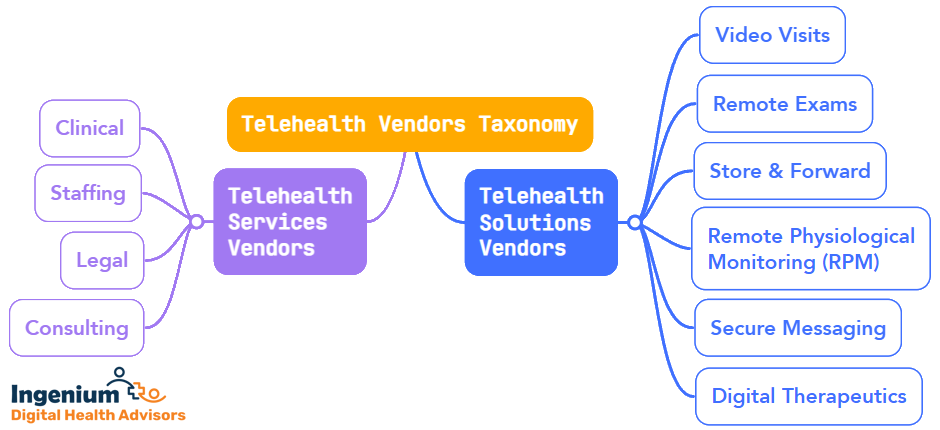Over the past 30 years, telehealth has evolved into a broad technology niche in its own right. At first there were telehealth hardware solutions – video cameras and video monitors, using proprietary video communication protocols and custom-fitted video connection software. Soon the hardware emphasis shifted to peripherals – tele-oscopes, such as digital stethoscopes, video otoscopes, video dermoscopes, etc.
With the increasing widespread use of the internet in the late 1990s and early 2000s and the introduction of the camera-heavy SmartPhones and the concept of apps in 2007, over time custom telehealth software solutions emerged, oftentimes with rapidly evolving feature sets — from televisits to teleexam platforms (allowing any-oscopes to be connected) to full-fledged EHRs.
Next, the business world (and the SmartPhone app world) “discovered” video visits and the availability of video platforms was democratized and rapidly evolved, becoming ubiquitously available.
Nowadays, there are numerous “Telehealth Solutions Vendors” across a number of categories to support “delivering care at a distance”, including:
- Video Visits
- Remote Exams
- Store & Forward
- Remote Physiological Monitoring (RPM)
- Secure Messaging
- Digital Therapeutics
Clinical Telehealth Service Vendors
About 15 years ago in the late 2000s, early 2010s, clinical telehealth service vendors started emerging, with Teladoc and American Well (now AmWell) being the first two big tele service providers catering either to self-insured companies to provide care to their employees or large health systems to augment their clinical staff.
Over time, other tele specialty care providers followed for neurology (“TeleStroke”), critical care (“TeleICU”), psychiatry, or hospital focused specialists (e.g., cardiology).
Another subset of clinical telehealth services also includes vendors providing support for remote physiological monitoring, such as a team of monitoring nurses that can work with patients to ensure measurement compliance or escalate patients to their primary care doctor.








Other Telehealth Services Vendors
In addition to vendors employing clinicians to virtually care for employees, insurance members, or a health system’s patients, a few other types of vendors providing services in the telehealth space have emerged over time:
Telehealth Staffing Vendors: Firms specializing in the recruitment and management of telemedicine clinicians and support staff.
Telehealth Law Firms: Lawyers and Law Firms with a focus on digital health and telehealth related legal and regulatory challenges.
Telehealth Consulting Firms: Boutique and general healthcare consulting firms with expertise in the launch, optimization, growth, and expansion of telehealth and digital health solutions and services.
Selecting a Telehealth Vendor
The selection of a Telehealth Vendor follows a proven process:
- Define your use cases, user needs, workflow requirements, technical specifications, vendor characteristics, etc.
- Identify and review vendors, periodically updating your criteria based on desirable features, functionality or characteristics you like.
- Test drive a vendor through a small scale, limited scope proof-of-concept with the purpose of validating assumptions.
- Select the vendor and deploy the solution or service across all clinicians, specialties, and/or sites.
Unfortunately many teams fail to put sufficient effort in the first step, but rather are focused on the dazzling presentation (mostly non-technical people, like clinicians, are prone to the ‘shiny object syndrome’) or focused on “making it work” with an existing vendor (mostly health IT leaders that are driven by minimizing contracts and a quest for tight integration).
I call this putting the horse behind the cart – buying a horse first and then figuring out what kind of cart the horse would have to….push.
Selecting and Integrating a Clinical Telehealth Services Vendor
While the selection of a telehealth services vendor such as a staffing or legal firm is pretty straightforward, for clinical telehealth services vendors, the highly tricky part is how to best integrate and merge the vendor’s remote clinicians with your clinical team and your infrastructure (such as your EHR).
Here’s a more specific workflow describing the process for selecting (and launching) a clinical telehealth services vendor:
- Create the strategic, business & clinical case
- Research the various service providers
- Selecting a service provider (vendor)
- Considerations for the onboarding process
- Develop the various service workflows
- Deploy the new workflows
Explore the detail behind each of those six steps in this article Outsourcing Telehealth Services: A Quick Guide.
A portion of this content was developed for and paid for by the Mid-Atlantic Telehealth Resource Center and can be found in the “Telehealth Vendor Selection Toolkit”.










To receive articles like these in your Inbox every week, you can subscribe to Christian’s Telehealth Tuesday Newsletter.
Christian Milaster and his team optimize Telehealth Services for health systems and physician practices. Christian is the Founder and President of Ingenium Digital Health Advisors where he and his expert consortium partner with healthcare leaders to enable the delivery of extraordinary care.
Contact Christian by phone or text at 657-464-3648, via email, or video chat.






